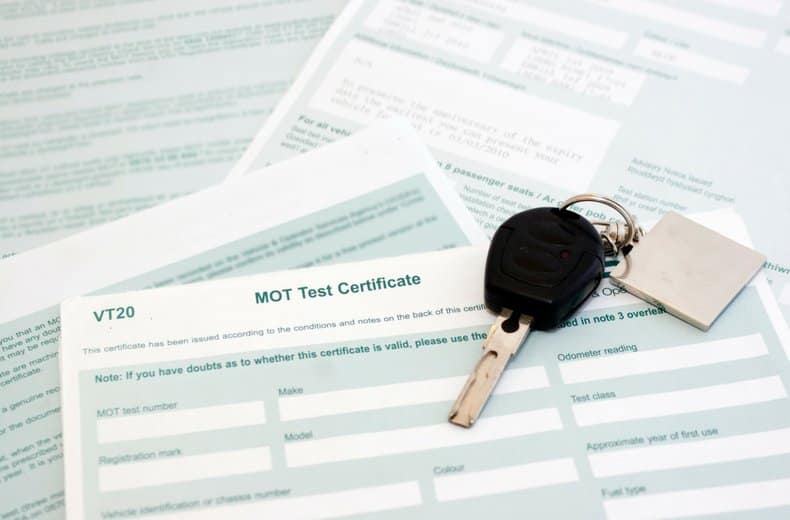Find out everything you need to know in our essential guide to 2018’s MOT changes.
Contents
Why are the MOT changes happening?
What do the new fault categories mean?

RAC Breakdown Cover
Limited Time Offer
*£7 a month for new, single vehicle Basic cover. ^For 1 nominated vehicle when added to Extra or Complete cover. New customers only. Ends 29/04/24. 7am.

What is the MOT test?
Currently in the UK, all cars over three-years-old must legally have an MOT test carried out every year by an approved testing centre.
The test checks the technical elements of your vehicle to make sure it’s safe to drive, and detects toxic emissions that could harm the environment.
The latest shake-up of the rules is designed to keep you and other road users safer, but many drivers are concerned about what the changes will actually mean.
MORE ADVICE: The most common MOT fails and how to avoid them
How is the MOT changing?
There are five key changes you need to know about so you don’t get caught out:
1. Defects categorised differently
If a fault is found during your MOT, it will be categorised as either:
Dangerous (Fail)
Major (Fail)
Minor (Pass)
2. Stricter rules for diesel car emissions
Any car that has been fitted with a diesel particulate filter (DPF) that gives out "visible smoke of any colour" during testing will get a major fault – an automatic fail.
It will also fail if the MOT tester finds evidence that the DPF has been tampered with.
3. New items tested during the MOT
In addition to the current checks, new elements will be added to the testing procedure. These include checking whether:
- Tyres are obviously underinflated
- Brake fluid has been contaminated
- Fluid has leaked, posing an environmental risk
- Reversing lights on all vehicles are functional
- Brake pad warning lights are lit, and if brake pads or discs are missing
- Headlight washers on vehicles first used from 1 September 2009 (if they are fitted)
- Daytime running lights on vehicles first used from 1 March 2018 (majority of these vehicles will have their first MOT in 2021 when they’re 3 years old)
ENGINE MAINTENANCE: RAC engine and fuel system cleaner from £14.99
4. Change to appearance of MOT certificate
The design of the MOT certificate will look different. It will list any defects under the new categories, so they’re clear and easy for motorists to understand.
The service to check the MOT history of a vehicle will be also updated to reflect the changes.
5. Some vehicles over 40 years old won’t need an MOT
At the moment, only vehicles made before 1960 are exempt from requiring an MOT.
From 20th May 2018, most vehicles won’t need an MOT from the 40th anniversary of when they were registered.
The only exceptions to this new rule are vehicles which have been ‘substantially changed’ within the last 30 years.
A vehicle will be considered ‘substantially changed’ if the technical characteristics of the main components have changed in the previous 30 years, unless the changes fall into specific categories.
These main components for vehicles, other than motorcycles are:
Chassis - (replacements of the same pattern as the original are not considered a substantial change) or Monocoque bodyshell including any sub-frames (replacements of the same pattern as the original are not considered a substantial change)
Axles and running gear – alteration of the type and/or method of suspension or steering constitutes a substantial change
Engine – alternative cubic capacities of the same basic engine and alternative original equipment engines are not considered a substantial change. If the number of cylinders in an engine is different from the original, it is likely to be the case that the current engine is not alternative equipment.
For full clarification over whether changes you’ve made to your vehicle exempt it from an annual MOT, read the full Government guidance online now before 20th May 2018.
Why are the MOT changes happening?

The new rules are being introduced as part of the EU roadworthiness directive, which comes into force on May 20 in member states.
Despite the UK voting to leave the EU, the changes are being implemented because we’re still a full member.
The new rules have been brought in to improve vehicle technology and maintenance across Europe to help reach the EU’s ‘zero vision’ objective of zero fatalities in road transport by 2050 and to ensure properly functioning vehicle emission control systems to help improve the environment.
MORE ADVICE: Diesel tax updates
What do the new fault categories mean?
MOT tests will no longer be a black and white case of ‘pass’ or ‘fail’. Instead, every fault found during the test will be categorised as dangerous, major or minor.
Dangerous
Cars that fall into this category are deemed an immediate risk to road safety, or have a serious impact on the environment. They will be subject to an automatic fail and should not be driven until the vehicle has been repaired.
Example – a steering wheel so loose it’s likely to become detached
Major
Cars with major defects will automatically fail the MOT and should be repaired immediately.
Example – oil is leaking from the steering box so badly that it’s dripping
Minor
Cars with minor defects will be allowed to pass and the faults will be recorded so you can get them repaired at a later date.
Example – there’s slight damage to brake hose
MOT testers will continue to give advice about items you need to monitor, known as ‘advisories’.

RAC Breakdown Cover
Limited Time Offer
*£7 a month for new, single vehicle Basic cover. ^For 1 nominated vehicle when added to Extra or Complete cover. New customers only. Ends 29/04/24. 7am.

What if my car has a ‘dangerous’ fault?
If your car is classed as having a dangerous defect it means you shouldn’t drive it away from the testing station until it’s fixed, as it’s not roadworthy and could endanger lives.
The law isn’t changing on this – it’s already illegal to drive a dangerous vehicle. This applies whether or not the vehicle still has a valid MOT certificate.
So in practice, not too much will change. The new system is simply designed to give you a clearer indication about the level of defect your vehicle might have.
READ NEXT: MOT checklist and comprehensive guide
So can I drive my vehicle away if it fails?
Testing centres don’t have the power to prevent you from driving a dangerous vehicle. You could still take it to another garage to get it repaired if you want, although you run the risk of being fined or receiving points on your licence for driving an unroadworthy vehicle.
If you’ve taken your car to a council-run MOT centre that doesn’t do repairs and it fails, you should get it recovered by a garage.
The RAC’s breakdown policy does not cover vehicles shown to be in an unroadworthy condition.
It’s your responsibility to make sure your vehicle is always kept in a roadworthy manner. This should be done by regular servicing and upkeep. Check out our guide to essential under-the-bonnet checks.
Want more useful content like this sent straight to your inbox?
Are you experiencing a car fault, warning, or mechanical problem on your road trip? Find a local mechanic with the RAC.
Need to insure a vehicle for a short period of time? Our temporary car insurance product is perfect if you're looking for flexible and comprehensive cover for between 1 hour and 30 days.






